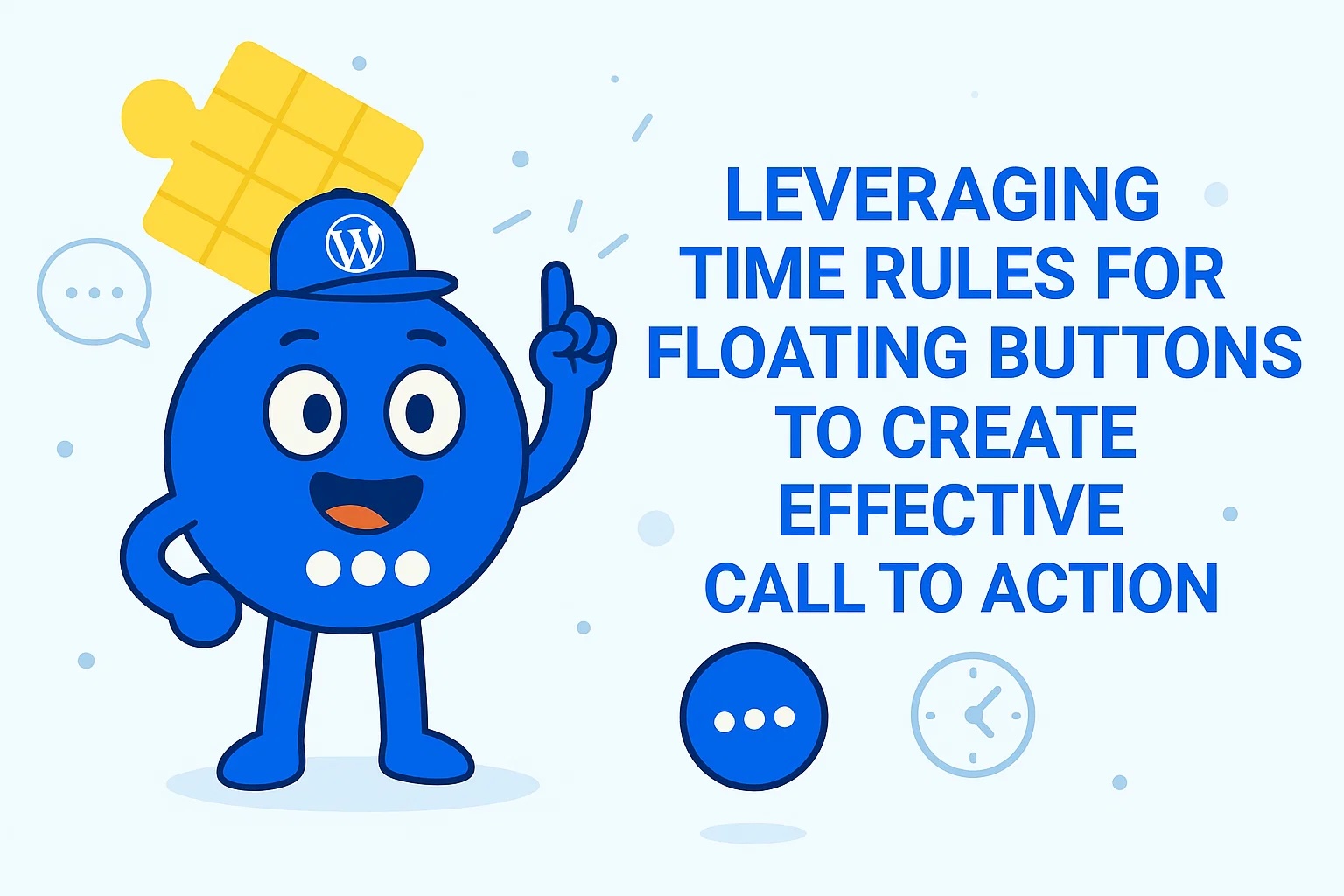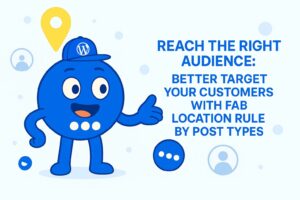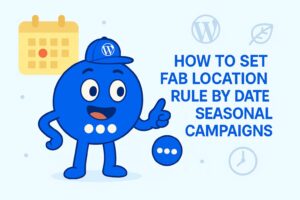Leveraging Time Rules for Floating Buttons to Create Effective Call to Action
The Floating Awesome Button (FAB) is a powerful WordPress plugin that allows you to add engaging and functional buttons to your website. FAB buttons stay visible as visitors scroll, helping them take immediate action, whether it’s contacting you, subscribing to your newsletter, or quickly navigating to the top of the page.
One of the most powerful features of FAB is its Location Rule functionality, which determines when and where the button appears on your website. Among the various location rules, time-based location rules stand out as an effective way to optimize user engagement and conversion.
Time-based location rules allow you to control when the FAB button is visible based on the time of day, making it a dynamic and context-aware tool. This article explores how you can leverage time-based location rules to enhance your website’s user experience and maximize the effectiveness of your floating buttons.
Understanding Location Rules in FAB
Location rules in FAB help define the visibility of buttons based on specific criteria. These rules determine where, when, and how a button should appear, allowing website owners to tailor the user experience based on their needs.
The three main types of location rules are:
- Page-Based Location Rules: These rules make the button visible only on specific pages or URLs.
- User-Based Location Rules: These rules determine the visibility of the button based on user behavior, such as logged-in status or past interactions.
- Time-Based Location Rules: These rules control when the FAB button appears based on the time of day, week, or other time-related triggers.
Time-based location rules are particularly powerful because they allow you to adjust the button’s visibility according to your audience’s browsing patterns. For example, you could display a special offer or reminder button during specific hours when your audience is most likely to engage.
What Are Time-Based Location Rules?
Floating Awesome Button (Sticky Button, Popup, Toast) & +100 Website Custom Interactive Element
Time-based location rules allow website owners to schedule when their FAB buttons should appear. For instance, you might want to show a “Sign Up Now” button in the evening, when users are more likely to browse your content. Alternatively, a “Limited Time Offer” button could be triggered during specific promotional hours.
These rules use time-related triggers, which could be:
- Specific Hours of the Day: The button appears only at certain times, such as between 9 AM and 5 PM.
- After a Certain Duration: The button becomes visible after a user has been on your website for a specific amount of time (e.g., after 30 seconds).
- Day of the Week or Month: The button appears on specific days, such as weekends or during a special event.
For example, a local business could use a time-based rule to display a “Special Offer” FAB during lunch hours to target people who are likely to be making decisions about food or service during that time frame.
Benefits of Using Time-Based Location Rules for FAB
Time-based location rules offer a multitude of benefits that can significantly improve the user experience and boost website conversions. These rules ensure that your FAB button is visible at the most opportune moments, increasing engagement and driving action. Let’s break down some of the key advantages:
- Enhanced User Experience and Satisfaction
- Contextual Relevance: By using time-based location rules, the FAB button appears when it’s most relevant to your audience. For instance, a “Call Us” button may be more effective during business hours, while a “Night Sale” button could appear after sunset. This personalized approach makes the website feel more intuitive and user-friendly.
- Reduced Distractions: Time-based rules allow you to show the FAB button only when it’s needed, rather than cluttering the page with unnecessary buttons all the time. This ensures a clean, distraction-free experience for users, which is especially important for mobile users who are likely to be more sensitive to excessive elements on the screen.
- Increased Conversion Rates
- Urgency and Action: Timing can create a sense of urgency. Time-based FAB buttons can be used for flash sales, limited-time offers, or countdowns, encouraging users to take action before time runs out. For example, an “Only 2 Hours Left!” button that appears during a flash sale can motivate visitors to act quickly, increasing the chances of a sale or subscription.
- Higher Engagement During Peak Hours: Time-based location rules allow you to target your users during peak engagement times, such as lunch hours, evenings, or weekends, when users are more likely to be active online. By showing your FAB button during these high-traffic periods, you maximize your chances of interaction, whether it’s a sign-up, a purchase, or another conversion goal.
- Personalized User Experience
- Dynamic Content Delivery: With time-based rules, you can customize the user experience based on the time of day or specific time intervals. For instance, a website can show different calls to action (CTA) buttons at different times. A morning CTA might focus on a “Start Your Day with Our Deal,” while an evening CTA might push for a “Last Chance for Today’s Discount.”
- Seasonal and Event-Based Customization: Beyond daily hours, time-based location rules can be adjusted to fit special events or holidays. For example, showing a “Holiday Sale” FAB during the Christmas season or offering a “Black Friday Special” button at the stroke of midnight on Black Friday ensures that your website is always in tune with what matters most to your audience at the time.
- Data-Driven Optimization
- Performance Analytics: When you set up time-based rules, you can track the performance of the FAB button during specific time slots. By analyzing data like click-through rates and conversion rates during different times of the day, you can optimize your strategy, ensuring that you are making the most out of your button’s visibility. For example, you might discover that your audience is more likely to engage with a “Sign Up Now” button in the late evening, prompting you to adjust the timing for future campaigns.
- A/B Testing for Optimal Timing: Time-based rules provide an excellent opportunity for A/B testing. You can experiment with different times to see which time slots yield the highest conversion rates, helping you make data-driven decisions about when your FAB button should be active. By testing and fine-tuning your time-based visibility, you can perfect your approach to match user behavior and website performance.
- Improved Focus on Core Conversion Goals
- Targeted CTAs for Different Goals: With time-based rules, you can tailor your calls to action based on the time of day and user intent. For example, a “Contact Us” FAB might be more effective during business hours when users expect support, while an “Exclusive Offer” button might be best displayed in the evening when users are winding down and more likely to consider special promotions. By aligning your FAB button visibility with user expectations, you can increase the likelihood of conversions that align with your website’s goals.
- Automated Time-Sensitive Campaigns: Time-based rules automate the process of launching campaigns during specific time frames, ensuring that you don’t miss out on key opportunities. For example, you could set up a campaign to automatically show a “Weekend Deal” button every Friday at 5 PM and hide it on Monday morning. This not only saves time but also ensures you are always promoting the right offer at the right time, without needing to manually adjust settings.
- Enhanced Mobile User Engagement
- Mobile-First Strategy: With mobile usage on the rise, it’s crucial to cater to mobile users with a user-friendly, streamlined interface. Time-based location rules can help ensure that the FAB button appears only when necessary on mobile devices, preventing the interface from becoming cluttered with too many elements. By focusing on specific times or events, the FAB button appears just when users need it, improving the overall mobile experience.
- Optimal Visibility for Smaller Screens: On mobile devices, screen space is limited, so showing the FAB button at the right time ensures it gets noticed without overwhelming the user. By using time-based location rules, you can show your FAB button during periods of high mobile engagement, making sure users interact with the button when they are most likely to respond.
How to Set Up Time-Based Location Rules for Your FAB Button
Setting up Location Rules for specific time in the Floating Awesome Button (FAB) plugin is simple and doesn’t require any technical knowledge. Here’s how to get started:
Step 1: Install and Activate the FAB Plugin
First, ensure that you have the Floating Awesome Button (FAB) plugin installed and activated on your WordPress website.
- Navigate to your WordPress Dashboard.
- Go to Plugins > Add New.
- Search for “Floating Awesome Button”.
- Click Install Now and then Activate the plugin once it is installed.
Step 2: Add New or Edit FAB Button
Once the plugin is activated, go to the FAB settings page to either create a new FAB button or edit an existing one.
- To edit an existing FAB button: Go to Admin > FAB > All FAB. Click on the Edit button for the FAB button you want to modify.
- To add a new FAB button: Go to Admin > FAB > Add New FAB. Here, you’ll create a new floating button and configure its settings.
Step 3: Enable Location Rules

In the FAB settings page, locate the Location Rule section. Here, you can specify conditions for when and where your button should appear. Firstly, you can select location type to Schedule > Time, then select the operator is equal to / is not equal to / is less than / is greater than / … , finally you’ll be presented with a dropdown menu that allows you to select which time you want to apply.
Step 4: Save Your Changes
Once you’ve set up your location rules, click Save to apply the settings.
- Now, your floating button will only appear on the specified date based on the location rules you’ve selected. This helps to tailor the user experience and ensure your call-to-action buttons appear where they are most relevant and impactful.
Case Studies: Time-Based FAB in Action
Time-based location rules are not just a theoretical concept but have been successfully implemented by businesses and websites around the world. These case studies demonstrate how time-based FAB buttons can transform user engagement, increase conversions, and enhance overall website performance. Below are a few real-world examples that showcase the power of using time-based FAB buttons:
- E-Commerce Website – Flash Sales and Time-Limited Discounts
- Scenario: An online fashion retailer wanted to boost sales during flash sales and time-sensitive promotions. They used time-based FAB buttons to promote a “Limited Time Offer” that appeared only during specific hours—usually between 6 PM and 9 PM—when their target audience was more likely to shop online.
- Implementation: The FAB button would display a prominent message like “50% Off for the Next 2 Hours” every evening during high traffic times. The time-based location rule ensured that the button was visible only during the promotion period, creating a sense of urgency.
- Results: By displaying the FAB button during the most active shopping hours, the retailer saw a significant increase in click-through rates and conversions. The urgency created by the time-based rule led to higher sales during the designated hours, with a 30% increase in daily sales compared to regular periods. The time-sensitive nature of the button encouraged users to act quickly, boosting both engagement and revenue.
- Restaurant Website – Reservation Reminders During Peak Meal Times
- Scenario: A popular local restaurant wanted to make it easier for users to make reservations, especially during busy meal times. They implemented a time-based FAB button that appeared during lunch (11 AM – 1 PM) and dinner (5 PM – 8 PM) hours to encourage users to book a table.
- Implementation: The FAB button was set to show up on the homepage during peak hours with a message like “Reserve Your Table Now.” Outside of these hours, the button would disappear, keeping the website clean and focused on other content.
- Results: The restaurant experienced a noticeable uptick in reservations during peak meal times. By targeting the exact hours when users were most likely to want to make reservations, they improved their conversion rate by 25%. Additionally, the time-based FAB button helped reduce user frustration by only showing relevant offers when they were needed, improving the overall user experience.
- Subscription-Based Service – Evening Free Trial Offer
- Scenario: A subscription-based service offering digital content (e.g., movies, music, or fitness classes) wanted to increase sign-ups for their free trial. They decided to use a time-based FAB button to promote the free trial in the evening when users were more likely to have time to engage with the service.
- Implementation: The FAB button with the message “Start Your Free Trial Now!” was set to appear from 6 PM to 10 PM each day. This time window targeted users who were winding down for the evening and looking for entertainment or fitness options.
- Results: By showing the FAB button only in the evening, the service was able to boost free trial sign-ups by 40%. Visitors were more likely to take action during these hours when they had time to explore the service, leading to higher conversion rates. The time-based rule helped the service effectively target users at the optimal time, increasing their sign-up rate and fostering new customer growth.
- Online Course Platform – Promotional Buttons for Course Enrollment
- Scenario: An online education platform offering specialized courses in technology and design needed a way to promote course enrollments during certain periods of the year, such as back-to-school months and holiday sales.
- Implementation: They used a time-based FAB button to display a “Sign Up for 20% Off!” message on the homepage during a specific 3-week period leading up to the new semester. The FAB button only appeared from 9 AM to 5 PM to align with business hours when potential students were most likely browsing the platform.
- Results: The time-based FAB button led to a 50% increase in course enrollments during the promotion period. By limiting the availability of the promotion to specific times, the platform was able to create a sense of scarcity and encourage users to sign up before the offer expired. Additionally, the timing helped ensure that only users who were actively browsing the site during those hours saw the offer, ensuring that the button’s visibility was optimized for maximum impact.
- Fitness Center – Limited-Time Class Offer
- Scenario: A fitness center wanted to promote special workout classes during slow periods when attendance was low. They used a time-based FAB button to display exclusive offers for early morning and late-night classes to boost attendance.
- Implementation: The FAB button with the message “Book Your Spot for Early Morning Class – 20% Off!” appeared on the homepage between 5 AM and 7 AM and then again between 9 PM and 11 PM. This was a targeted effort to engage users during off-peak hours.
- Results: The fitness center saw an increase in class bookings during the targeted times, with a 15% rise in early morning class attendance and a 20% increase in late-night bookings. The time-based FAB button was effective in attracting users during non-peak hours, and the targeted discounts made the classes more appealing. By using a time-based rule, the fitness center was able to fill up classes that typically had lower attendance.
- Travel Website – Limited-Time Flight Deals
- Scenario: A travel website offering discounted flights wanted to encourage users to book their trips during specific hours when the lowest fares were available. They implemented a time-based FAB button to display exclusive “Limited Time Flight Deals” during off-peak hours.
- Implementation: The FAB button was set to show up between 9 PM and midnight, offering flash flight sales for the next day. The button’s message was “Book Now – 25% Off Your Next Flight.”
- Results: The time-based FAB button successfully drove an increase in flight bookings during late-night hours, with a 35% rise in bookings compared to the same hours in previous months. By targeting users during times when they were more likely to make last-minute travel decisions, the website effectively capitalized on urgency, leading to more flight reservations and increased sales.
Conclusion
Time-based location rules for FAB buttons are a simple yet powerful way to enhance user engagement and increase conversions on your website. By showing your button at the right time—whether it’s during peak hours, special events, or after a user has been on your site for a while—you can improve the overall user experience and encourage timely actions.
By following the steps outlined above and implementing best practices, you can start using time-based rules to make your FAB buttons work harder for you. With a little optimization and testing, your website will be more interactive, relevant, and engaging than ever before.







